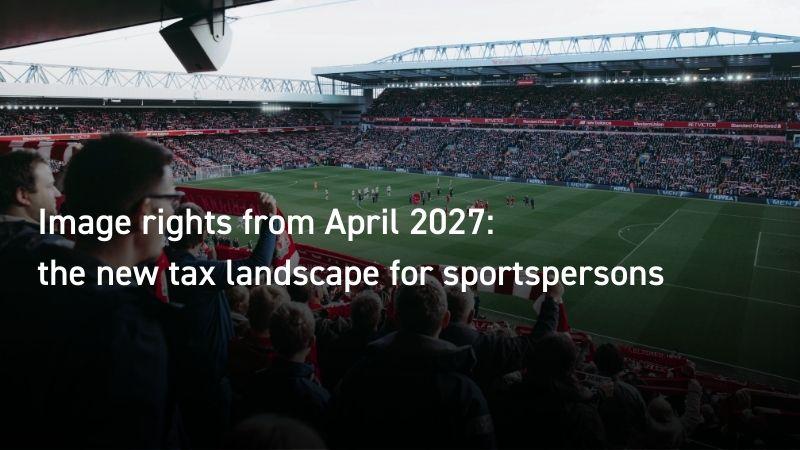
Summary of Autumn Budget – Image Rights
As part of a wider package of tax-administration and compliance reforms looking to raise £2.3bn, hidden in the detail of the budget was a potentially significant change to the taxation of image rights payments.
This specific measure could raise an estimated £40m according to HM Treasury’s Budget Policy Costings in tax revenues per annum and therefore a modest amount in comparison but it’s potential impact on the sports industry may be monumental.
From 6 April 2027, it is proposed that all image right payments related to an employment will be treated as taxable employment income, subject to income tax and both employer and employee NICs.
Key points:
1 Is this the end of the traditional image rights structure?
The current structure (used by top tier football and many other team sport clubs) involves contracting separately with a player’s image right company for commercial services.
Under the propositions, if there is link between employment and image right payments, the latter will no longer benefit from PAYE & NIC exclusions.
More information is required on exactly how this will apply.
2 ‘Sports Club’ case effectively displaced?
This change will seemingly override the long-standing position taken in Sports Club & Others v HM Inspector of Taxes (2000), which allowed certain commercial image right arrangements to sit outside PAYE, based on genuine commercial arrangements which could be identified and were separate to employment income for playing services.
It should be noted that this decision was not legally binding however, in the absence of an appeal (which did not happen), the significance of the decision should not be understated.
From April 2027, will this mean that this case is irrelevant? It may be hard for HMRC to ignore the parallels that exist between this case and many current arrangements. However, (clear) legislation would take precedent over this case.
3 Significant cost implications for clubs
Clubs could be hit with the following tax burden:
4 Impact on players
Players may face:
5 Will third-party sponsorship deals be affected?
Genuine sponsorship and commercially independent deals should still fall outside employment income. How this would interact with shared sponsors between club and player is unclear.
6 Other potential updates which could impact sportspeople
To be published in early 2026 are details of measures that will require income tax self-assessment taxpayers with PAYE income to pay more of their Self-Assessment liabilities in-year via PAYE from April 2029.
The majority of sportspeople receive investment income and we assume HMRC are looking to receive the tax on this income via their tax code.
The difficulty currently is that agent fees are coded and therefore HMRC are unable to collect more than 50% of gross pay via PAY (50% regulatory limit).
7 Payrolling benefits
The mandatory payrolling of most benefits was announced in the previous budget and is due to take effect from 6 April 2027.
What is unclear is how payments made to a players agent on their behalf by an employer (i.e. a pecuniary liability) will be payrolled. Agency fees are normally paid once or twice a year.
From a practical sense, how will tax be collected on these benefits; agency fees are payable after they are due.
Take an example of professional footballers; September (end of summer football transfer window) is the earliest month that agent fees can be paid in a tax year. Therefore, from September onwards (i.e. halfway through the tax year), the tax due on agency fees will be payrolled. This leaves 6 months in the tax year to collect the tax due, notwithstanding the aforementioned point regarding the 50% regulatory limit.
Employers have the option to forgo payrolling benefits and whether every employer in the Sports industry operates the same way is uncertain. What is undoubtable is that sportspeople (especially footballers who pay large agency fees) will be left with a tax underpayment at the end of the year.
Closing
Particularly interesting (well to us at least) was the wording of the full budget which stated ‘the use of image rights to avoid employment income’. Genuine image right payments reflect the commercial relationship that a professional sportsperson (with an image that may be cultivated from their time before their current club and off-field activities) has with their engaging club.
This also gives a potential insight into future HMRC investigative action, which previously has challenged clubs (from 6 April 2021) and not players on such arrangements.
It should be noted that image right companies will still form a valuable part of tax planning for off-field activities.
More detail is required from HMRC but what is clear is that change will happen from April 2027 and advisors, clubs and all those working with Sportspeople will need to be aware that longstanding current arrangements may no longer work in the same way.
Planning will be key here to ensure that contracts in particular are compliant and sponsorship deals are potentially isolated.
Finally, the ‘payrolling benefits’ mechanism of tax collection may alleviate cash flow issues but our concern is that if clear guidance is not given to employers within the Sports industry, it could create the exact problem it is seeking to remediate.
Contact us
For tailored advice on restructuring image right arrangements, planning for the 2027 changes, and queries regarding payrolling benefits, please contact our Sports team.
We’d love to hear from you. To book an appointment or to find out more about our services: